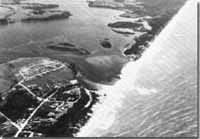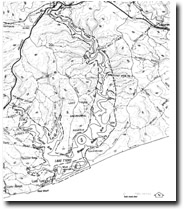8522-6 Lake Tyers Entrance and Tidal Delta
|
This information has been developed from the publications:
|
Location: | 960100. Lake Tyers. |  Tidal delta - Lake Tyers. |
Abstract: | Barrier beach, tidal delta islands and shoals. | |
Access: | Boat from Lake Tyers. | |
Ownership: | Crown land. | |
Geology/Geomorphology: | The entrance to Lake Tyers is frequently closed by a barrier beach for periods of several years. The entrance has been occasionally artificially or more commonly is breached by storm waves leading to rapid outflow and lowering of lake levels. The detailed regime of entrance closure is not known but in earlier Holocene times there must have been long periods of opening with considerable flood tide inflow. This inflow has resulted in a sandy, tidal delta forming in the lower lake at Lake Tyers. There are two groups of delta islands - and inner group of four islands vegetated by sedges, reeds and other grasses, and Banksias which are partly submerged when the entrance remains closed for several months. These islands would have developed when the entrance was open more frequently than is now the case. The second group consists of migrating sandy shoals and bars that lie immediately behind the barrier beach and represent tidal delta deposition that takes place during the limited periods the entrance is now open. | |
Significance: | Regional. The two stages of tidal islands may be related to changing sea levels and can be compared with similar features at Mallacoota Inlet. | |
Management: | More frequent artificial opening of the entrance increasing salinity and current flow in the lake may lead to erosion of the inner group of vegetated islands but will cause accretion or enlargement of the second group. It is recommended that the natural cycle of entrance opening and closure be allowed to continue | |



